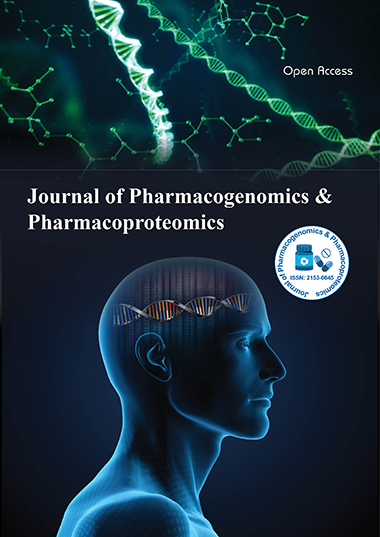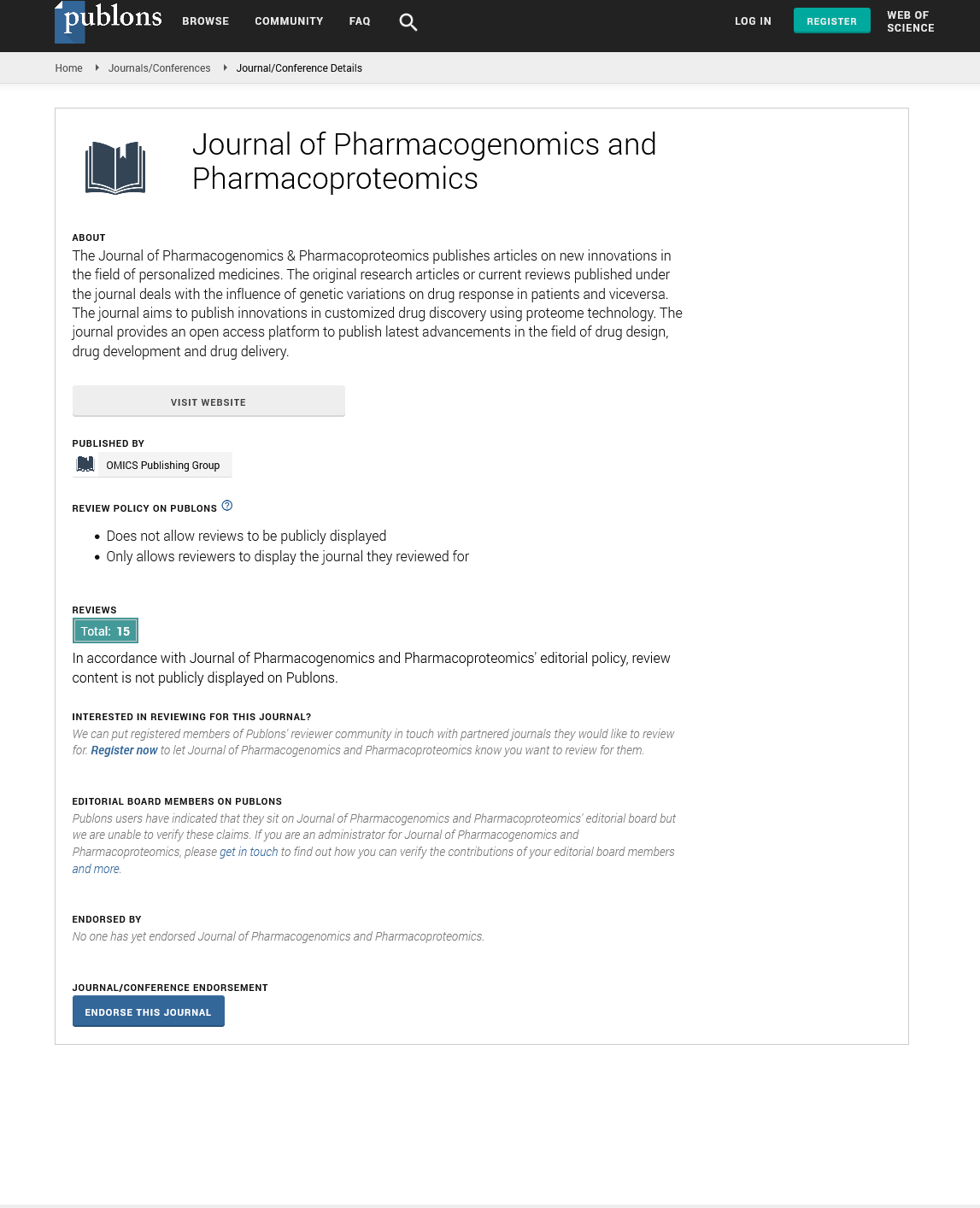Indexed In
- Open J Gate
- Genamics JournalSeek
- Academic Keys
- JournalTOCs
- ResearchBible
- Electronic Journals Library
- RefSeek
- Hamdard University
- EBSCO A-Z
- OCLC- WorldCat
- Proquest Summons
- SWB online catalog
- Virtual Library of Biology (vifabio)
- Publons
- MIAR
- Euro Pub
- Google Scholar
Useful Links
Share This Page
Journal Flyer

Open Access Journals
- Agri and Aquaculture
- Biochemistry
- Bioinformatics & Systems Biology
- Business & Management
- Chemistry
- Clinical Sciences
- Engineering
- Food & Nutrition
- General Science
- Genetics & Molecular Biology
- Immunology & Microbiology
- Medical Sciences
- Neuroscience & Psychology
- Nursing & Health Care
- Pharmaceutical Sciences
Perspective - (2024) Volume 15, Issue 4
Toxicogenomics and the Development of Biomarkers for Predicting Toxicity in Drug Discovery
Received: 25-Nov-2024, Manuscript No. JPP-24-27922; Editor assigned: 29-Nov-2024, Pre QC No. JPP-24-27922 (PQ); Reviewed: 16-Dec-2024, QC No. JPP-24-27922; Revised: 24-Dec-2024, Manuscript No. JPP-24-27922 (R); Published: 31-Dec-2024, DOI: 10.35248/2153-0645.24.15.118
Description
Drug discovery is a complex and time-consuming process, with one of the most critical challenges being the prediction and assessment of drug toxicity. Adverse Drug Reactions (ADRs) are a significant cause of drug withdrawal from the market, affecting not only patient safety but also the economic viability of pharmaceutical companies. Historically, toxicity has been assessed using animal models and in vitro cell-based assays, but these approaches often fail to predict human responses accurately. The integration of toxic genomics the study of how genetic variation influences responses to toxins, including drugs has emerged as a promising approach to enhance the safety and efficacy of drug discovery processes.
Toxicogenomics combines high-throughput technologies, such as genomics, transcriptomics, proteomics and metabolomics, to understand how chemicals, including pharmaceuticals, affect the genetic material and cellular machinery. One of the most promising applications of toxic genomics is the development of biomarkers that can predict the toxicity of drugs, providing a more reliable and efficient method for identifying potential safety risks early in the drug development process. This manuscript explores the role of toxic genomics in predicting drug toxicity, the types of biomarkers being developed and the challenges and opportunities in applying this field to drug discovery.
Toxicogenomics aims to identify the molecular mechanisms underlying toxicity by analyzing the effects of drugs and chemicals on gene expression, protein function and metabolic pathways. Traditional methods of toxicity testing, such as clinical trials and animal studies, are expensive, time-consuming and may not always provide accurate predictions for human toxicity. Toxicogenomics offers a more precise approach by analyzing the biological responses at the molecular level, providing a better understanding of the mechanisms that contribute to toxicity.
One of the major advantages of toxic genomics is its ability to identify early markers of toxicity before significant damage occurs. By using genomic techniques to assess changes in gene expression or the activation of specific signaling pathways, researchers can detect adverse effects at much earlier stages of drug development. This early detection allows for the optimization of drug candidates, reducing the likelihood of latestage drug failures due to toxicity. Toxicogenomics enables the identification of genetic variations that influence individual responses to drugs. These genetic differences, which can be linked to specific genetic polymorphisms or mutations, can help predict whether a patient is more likely to experience an adverse reaction to a particular drug. This personalized approach can lead to safer, more effective treatments tailored to an individual's genetic makeup.
Biomarkers are biological indicators that can be measured to assess the effects of a drug or chemical on the body. In the context of Toxicogenomics, biomarkers are used to detect early signs of toxicity, predict the potential for adverse drug reactions and determine the mechanisms responsible for drug-induced damage. The development of reliable biomarkers is essential for improving drug safety and minimizing the risks associated with new drugs.
There are several types of biomarkers in Toxicogenomics, including genetic biomarkers, transcriptomic biomarkers, proteomic biomarkers and metabolomics biomarkers. Genetic biomarkers are related to genetic variations that may influence how a drug is metabolized or how it interacts with cellular targets. Single Nucleotide Polymorphisms (SNPs), insertions, deletions, or mutations in specific genes can impact drug metabolism or cellular responses, increasing the likelihood of toxicity. By identifying genetic variations that are associated with adverse drug reactions, researchers can predict which patients are at higher risk for toxicity.
Transcriptomics analysis involves measuring gene expression changes in response to drug exposure. Drugs can induce the up regulation or down regulation of specific genes, which can be used as biomarkers of toxicity. For example, changes in the expression of genes related to inflammation, apoptosis, or oxidative stress can indicate the potential for drug-induced damage. By analyzing the gene expression profiles in cells or tissues exposed to drugs, researchers can identify early biomarkers for liver toxicity, nephrotoxicity, or cardio toxicity.
Proteomics is the study of the entire set of proteins expressed in a cell or tissue. Drug-induced changes in protein expression or post-translational modifications can serve as biomarkers for toxicity. For instance, the up regulation of certain proteins involved in the stress response or DNA repair mechanisms may indicate cellular damage. Proteomic biomarkers can provide insight into the mechanisms of toxicity and help identify early signs of adverse reactions.
Citation: Vojnits X (2024). Toxicogenomics and the Development of Biomarkers for Predicting Toxicity in Drug Discovery. J Pharmacogenom Pharmacoproteomics. 15:118.
Copyright: © 2024 Vojnits X. This is an open-access article distributed under the terms of the Creative Commons Attribution License, which permits unrestricted use, distribution, and reproduction in any medium, provided the original author and source are credited.

